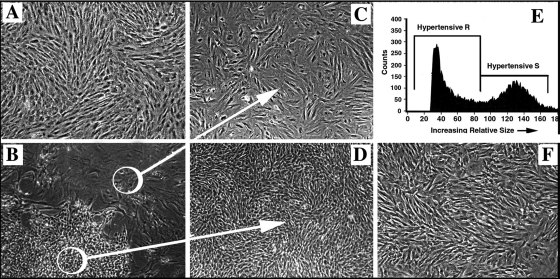Fig. 2.
In primary culture, dPA media of chronically hypoxic calves yields phenotypically distinct cell populations. A: primary cultures isolated from the dPA media of control calves consistently yield a morphologically uniform population of cells. B: in contrast, primary cultures obtained from the dPA media of chronically hypoxic calves consistently yield 2 morphologically distinct cell types. C and D: the 2 morphologically distinct cell types [termed dS-SMC (C) and dR cells (D)] observed in primary cultures of chronically hypoxic calves (B) can be selectively isolated as uniform populations (see methods). When expanded in subculture, both cell populations maintain their morphological differences (passage 4 is shown) as well as the differences in cell size (E; passage 5 is shown) as demonstrated by FACS-based analysis performed by forward scatter (dR cells are significantly smaller in size than dS-SMC). F: fibroblasts, obtained from the same dPA used for isolation of medial cells, appear morphologically different from dR cells (shown in D).

